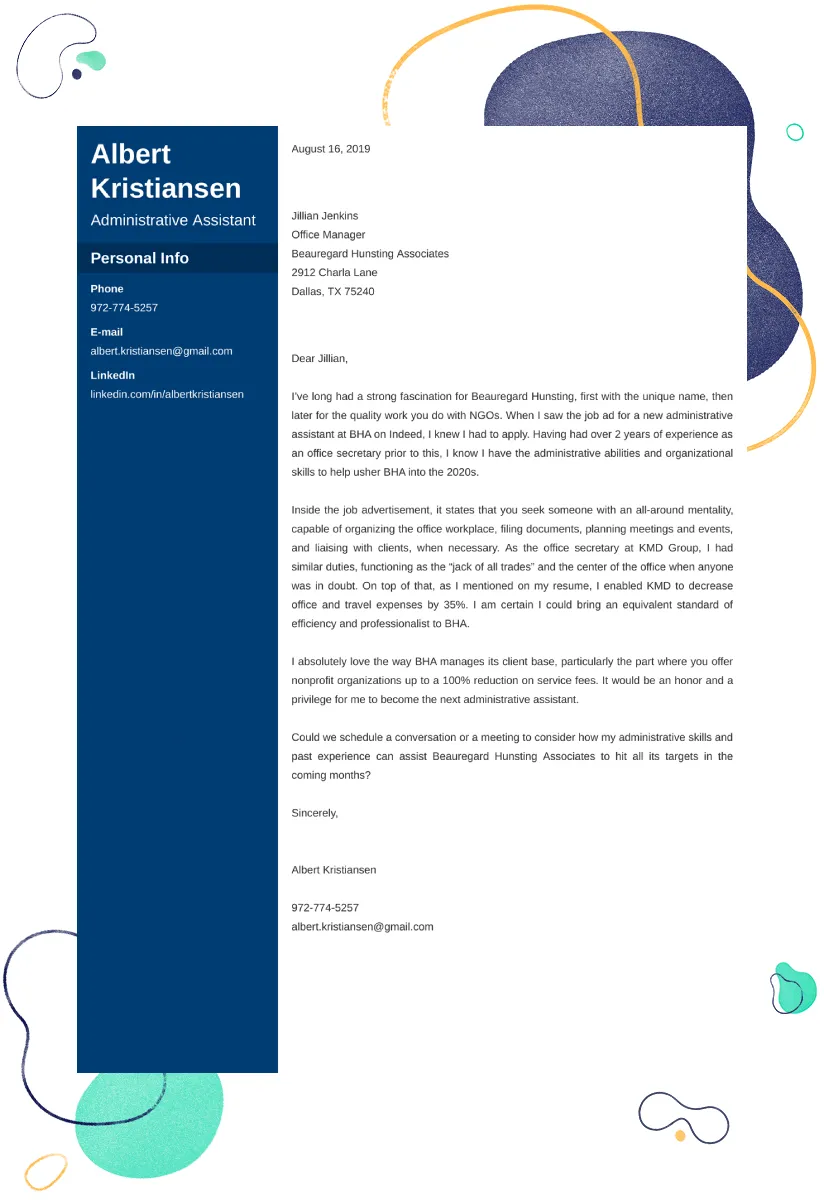Understanding the Purpose of a Cover Letter
A cover letter serves as your introduction to a potential employer, offering a chance to go beyond the details provided in your resume. It’s your first opportunity to make a strong impression and demonstrate your suitability for the administrative assistant position. Think of it as a sales pitch, where you highlight your key skills, experience, and why you’re the perfect fit for their needs. A well-crafted cover letter should grab the hiring manager’s attention and encourage them to read your resume with interest. It should explain why you are applying for the job, and what excites you about the company and the specific role. Make sure your cover letter is easy to read, well-organized, and personalized to the specific job you are applying for. Do not just send out a generic cover letter, be sure to make it relevant to the specific job.
Why a Cover Letter Matters
While your resume provides a snapshot of your qualifications, a cover letter adds context and personality. It allows you to explain gaps in your employment history, elaborate on your skills, and express your enthusiasm for the role. For an administrative assistant position, a cover letter is particularly important, as it showcases your communication and organizational skills. It proves you have the ability to write professionally, and it also displays your attention to detail. Many employers use the cover letter as a first test of your communication skills and your ability to present yourself professionally. A well-written cover letter can significantly increase your chances of getting an interview, even if your resume isn’t perfect. It allows you to stand out from other candidates and show that you’ve put in the extra effort.
What to Include in Your Cover Letter
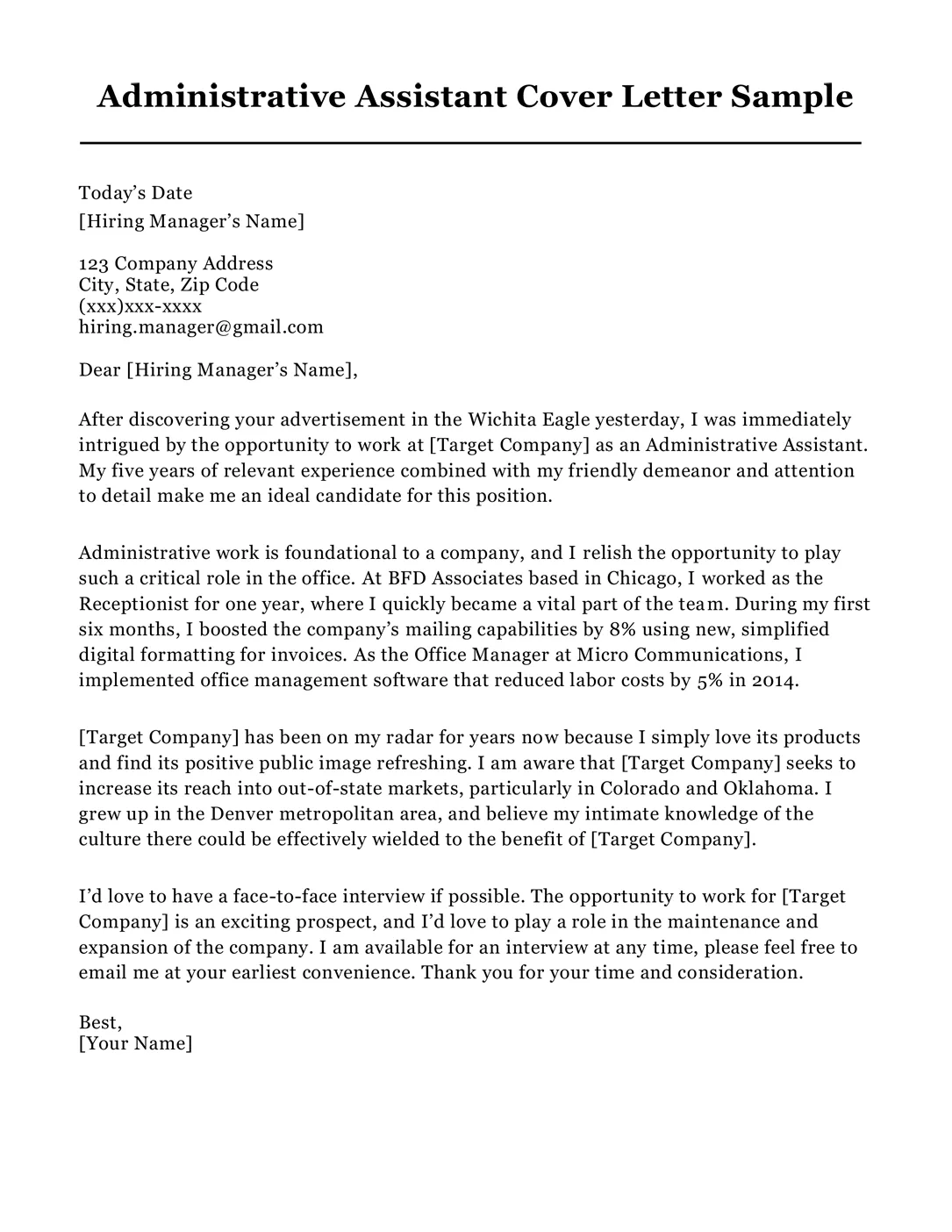
Your cover letter should follow a standard business format, including your contact information, the date, and the recipient’s information. Start with a professional greeting, such as “Dear Mr./Ms. [Last Name].” The body of your letter should be concise and focused, typically including three to four paragraphs. The first paragraph should state the position you’re applying for and how you learned about it. The following paragraphs should highlight your relevant skills and experience, providing specific examples of your achievements. Always tailor your cover letter to align with the specific requirements of the job description. Emphasize how your qualifications meet their needs. Finally, your cover letter should end with a call to action, expressing your interest in an interview.
Highlighting Relevant Skills
Administrative assistant positions require a diverse set of skills. Your cover letter is the perfect place to showcase these. Start by identifying the key skills mentioned in the job description, such as communication, organization, time management, and proficiency in specific software programs. Then, provide concrete examples of how you’ve utilized these skills in previous roles. For example, instead of simply stating that you have excellent organizational skills, describe a situation where you successfully managed multiple projects simultaneously, or developed an efficient filing system. When describing your skills, use action verbs like “managed,” “coordinated,” “organized,” and “implemented.” Quantify your accomplishments whenever possible. For instance, “Improved office efficiency by 15% by implementing a new scheduling system.”
Showcasing Experience Effectively
Your cover letter should demonstrate a clear progression of your experience. Start by mentioning your most recent or relevant job and briefly describe your responsibilities. Then, highlight specific achievements that are relevant to the administrative assistant role. Focus on accomplishments rather than simply listing your duties. For example, instead of saying, “Managed phone calls,” you could say, “Effectively managed a high volume of incoming calls, providing exceptional customer service and directing inquiries to the appropriate departments.” Use the STAR method (Situation, Task, Action, Result) to structure your examples. This approach helps you provide a clear and concise overview of your experience, illustrating your abilities to the hiring manager. Show that your experience aligns with the requirements of the role and that you are the right person for the job.
Formatting Your Cover Letter
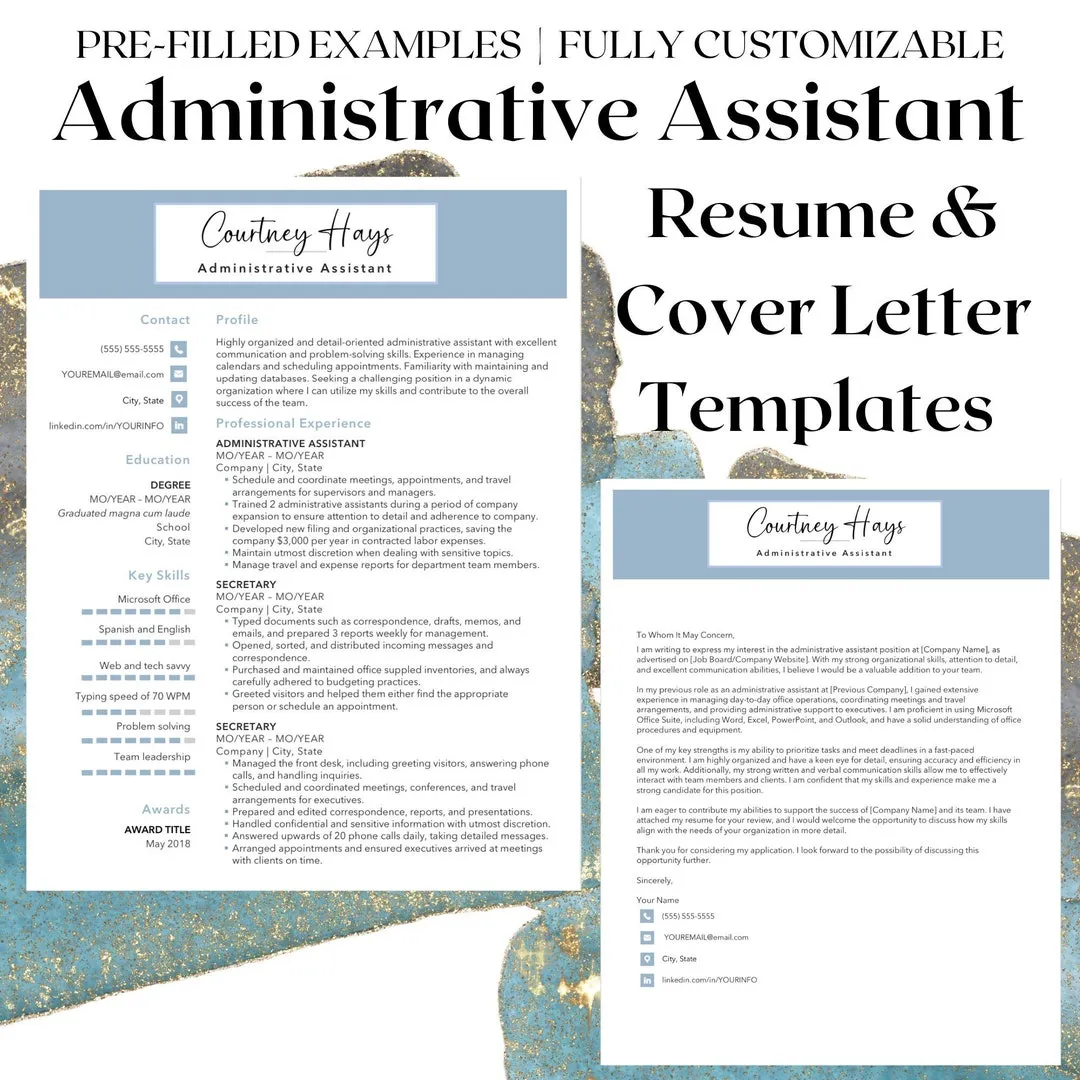
The format of your cover letter is just as important as its content. It must be well-organized, easy to read, and visually appealing. Use a professional font, such as Times New Roman, Arial, or Calibri, with a font size between 10 and 12 points. Make sure that you have consistent spacing throughout the letter, and use a clear, easy-to-read font. Use paragraphs to separate your ideas and keep your sentences concise and to the point. Avoid long, dense blocks of text. Use bullet points or numbered lists to highlight your skills or accomplishments, which makes your cover letter more readable. Consider using a simple template to ensure a professional appearance. Always proofread your cover letter carefully to ensure that it is free of grammatical errors and typos.
Proper Font and Formatting
Using the right font and formatting can make your cover letter more readable and professional. Stick to standard, professional fonts like Times New Roman, Arial, or Calibri. These fonts are easy to read and are widely accepted in business communication. The font size should be between 10 and 12 points, ensuring that the text is not too small or too large. Use clear formatting, with consistent margins and spacing. The goal is to make the cover letter visually appealing and easy to scan. Use bolding or italics sparingly, to highlight key information. Avoid using excessive formatting, as it can distract from the content of your letter. Ensure that your cover letter aligns with the company’s brand if it has a specific formatting style, otherwise keep it clean and simple.
Structuring the Letter
Structure your cover letter with a clear beginning, middle, and end. Start with a professional greeting, addressing the hiring manager by name if possible. The first paragraph should state the position you’re applying for and where you found the job posting. In the middle paragraphs, highlight your relevant skills and experience, using specific examples to demonstrate your accomplishments. Tailor these examples to match the job requirements, showing how your skills and experience align with what the company is looking for. The final paragraph should express your enthusiasm for the role and reiterate your interest in an interview. End with a professional closing, such as “Sincerely” or “Best regards,” followed by your signature and typed name. This structure makes your cover letter organized and easy to read.
Common Mistakes to Avoid
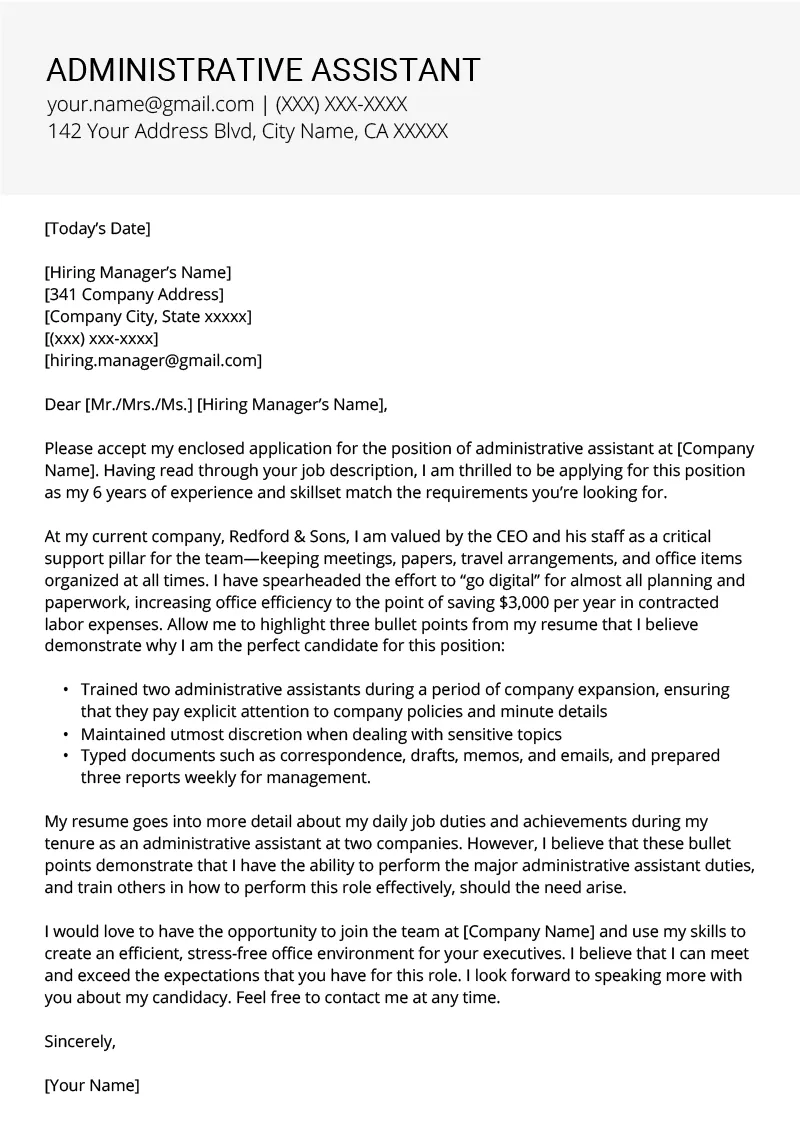
Several common mistakes can undermine your cover letter. Avoid generic, one-size-fits-all cover letters, and tailor each letter to the specific job and company. Don’t simply repeat information from your resume; instead, use the cover letter to elaborate on your skills and experience. Avoid grammatical errors and typos, as they can damage your credibility. Don’t be too casual or informal in your language. Maintain a professional tone throughout your letter. Do not ramble or be overly wordy; keep your cover letter concise and focused. Avoid negative language or complaints about previous employers, instead, focus on what you can bring to the company. Make sure that you follow the instructions provided in the job description, and customize your cover letter accordingly.
Grammar and Spelling Errors
Grammatical errors and spelling mistakes are a major turnoff for hiring managers. Before submitting your cover letter, proofread it carefully for any errors. Use a grammar checker to catch mistakes you might miss. Pay close attention to punctuation, capitalization, and sentence structure. A cover letter riddled with errors suggests a lack of attention to detail. Always proofread carefully. Ask a friend or colleague to review your cover letter for a fresh perspective. Even small errors can create a negative impression and diminish your chances of being selected for an interview. Proper grammar and spelling demonstrate your professionalism and attention to detail, essential qualities for an administrative assistant.
Generic Cover Letters
Submitting a generic cover letter is a common mistake that can instantly disqualify your application. Employers can easily tell when a cover letter has not been tailored to the specific job and company. Generic letters lack personality and fail to demonstrate your genuine interest in the role. Always customize your cover letter to reflect the specific requirements of the job description. Research the company and understand its values and culture. Mention specific aspects of the company or the role that excite you. This shows the hiring manager that you’ve taken the time to understand their needs. Personalize your cover letter by addressing the hiring manager by name. This demonstrates that you have taken the time to find out who they are.
Tailoring Your Cover Letter
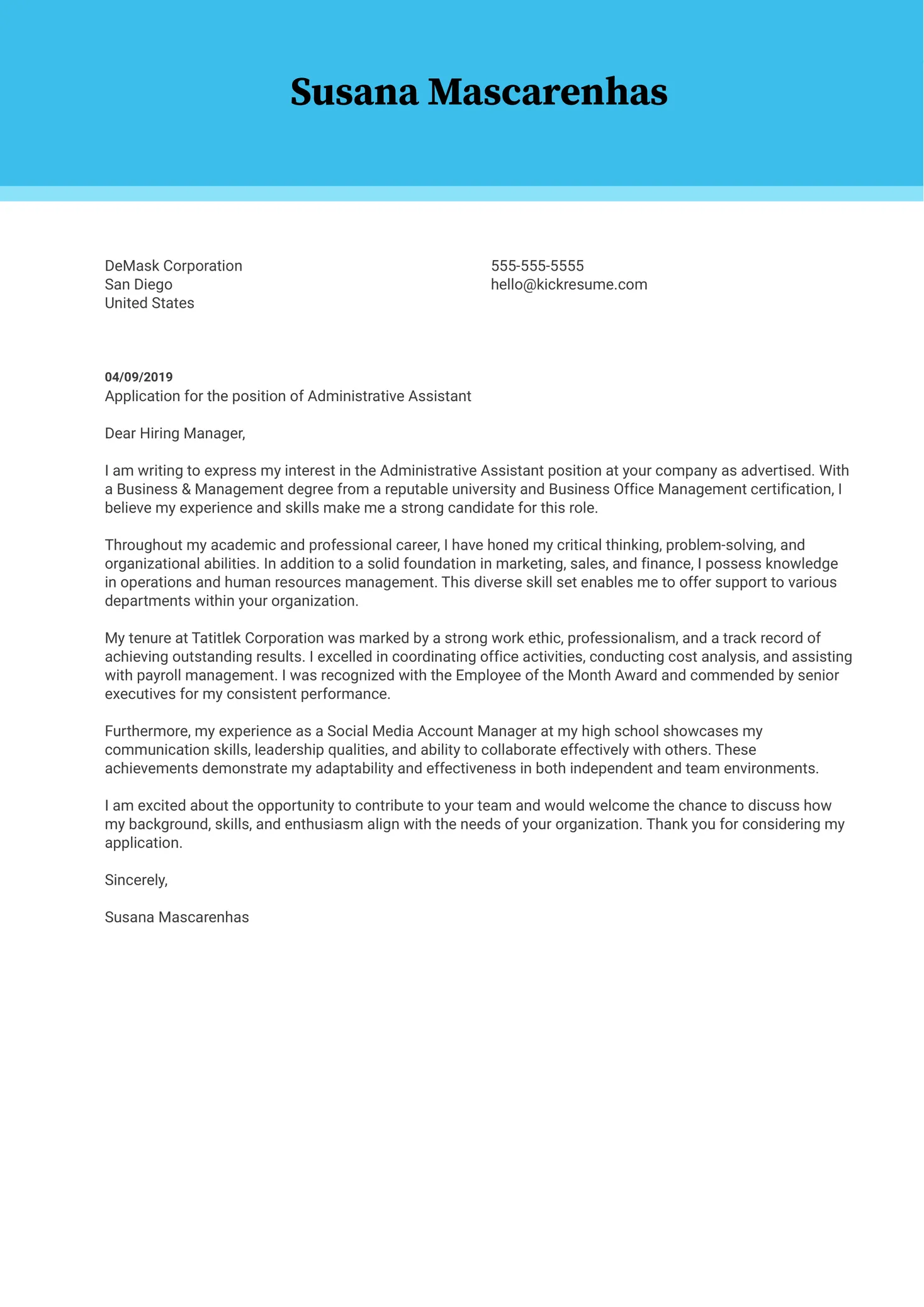
Tailoring your cover letter is essential for making a strong impression. Begin by carefully reviewing the job description, identifying the key skills, experiences, and qualifications the employer is seeking. Then, highlight your relevant skills and experiences that directly align with these requirements. Use the language from the job description in your cover letter to show that you understand the role and what the employer is looking for. Research the company to learn about its mission, values, and culture. Show how your skills and experience align with the company’s goals. Customize your letter by mentioning specific aspects of the company or the role that interest you. Tailoring shows that you’ve taken the time to understand the role and the company.
Researching the Company
Researching the company is a crucial step in tailoring your cover letter. Visit the company’s website to learn about its mission, values, products, and services. Explore their social media presence to get a sense of their culture and brand. Identify any recent news or projects that the company is involved in. Use this information to demonstrate your understanding of the company and your genuine interest in the role. Show how your skills and experience align with the company’s goals and values. This demonstrates that you’ve taken the time to learn about the company and that you’re not just sending a generic application. Use the company’s name in your cover letter to show you have customized your letter to the specific job and organization. Mention any specific projects or initiatives that resonate with you.
Customizing Your Content
Once you’ve researched the company, customize the content of your cover letter. Address the specific requirements and skills mentioned in the job description. Use the language from the job posting to demonstrate your understanding of the role. Highlight relevant experiences and achievements that showcase your abilities. Provide specific examples of your accomplishments, using the STAR method. Quantify your achievements whenever possible. Demonstrate how your skills and experience align with the company’s values and goals. Tailor your letter by mentioning specific aspects of the company or the role that excite you. Proofread your cover letter to make sure that you have customized it to the specific job and company. By taking these steps, you can significantly increase your chances of making a positive impression.
Reviewing and Proofreading
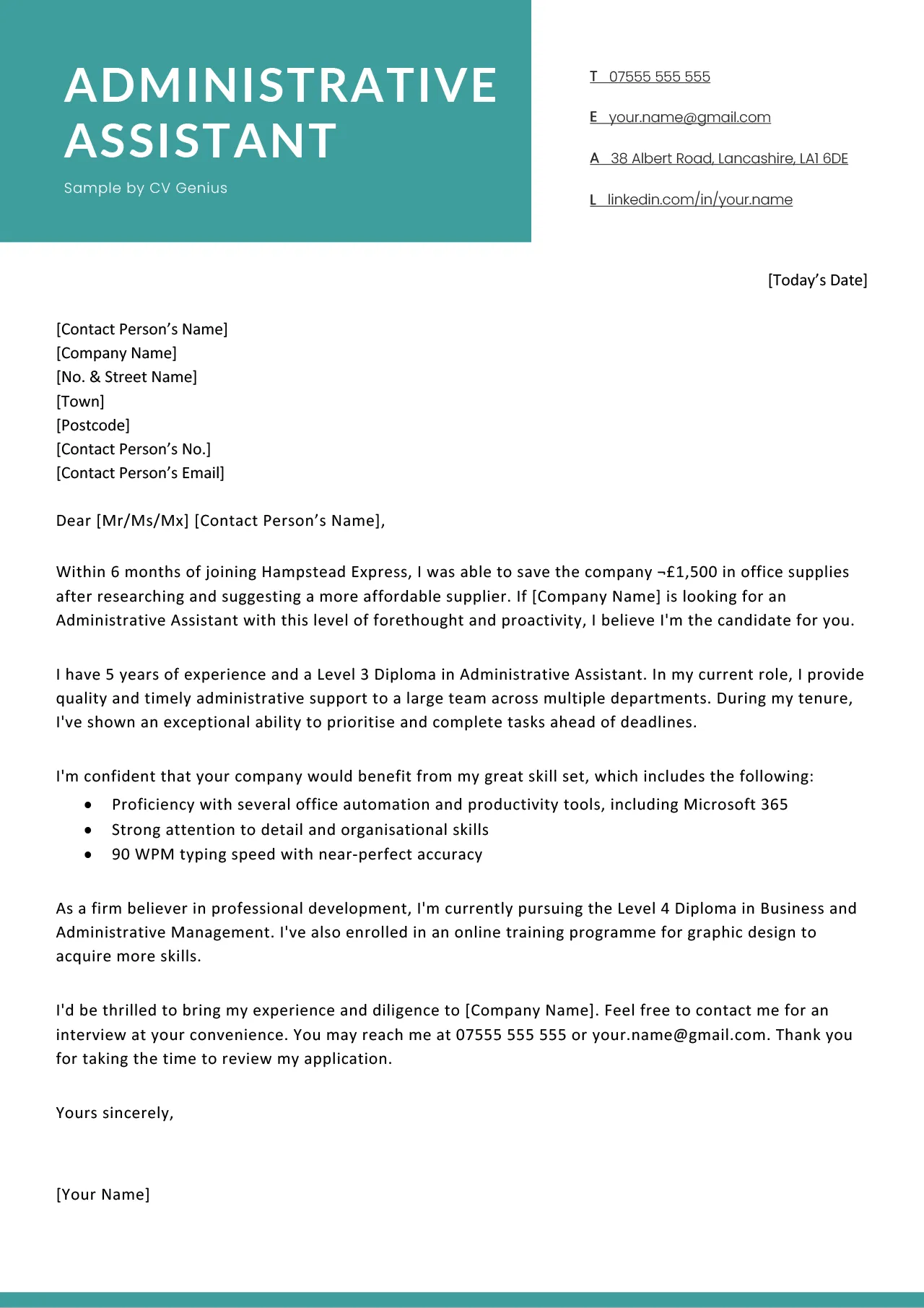
Before submitting your cover letter, take time to review and proofread it carefully. Check for any grammatical errors, typos, or inconsistencies in your formatting. Make sure your cover letter is easy to read and well-organized. It should have a clear structure and logical flow. Ensure that your content is relevant to the job description and that you’ve highlighted your key skills and experience. Ask a friend, family member, or career counselor to review your cover letter for feedback. A second pair of eyes can catch errors you might have missed. Proofreading is an essential step in ensuring that your cover letter makes a positive impression. This demonstrates your attention to detail.
Seeking Feedback
Getting feedback on your cover letter is an invaluable step in the job application process. Ask a trusted friend, family member, or career counselor to review your cover letter. They can provide a fresh perspective and identify any areas for improvement. Share your cover letter with professionals in your field, if possible. They can offer insights into industry standards and best practices. Pay attention to the feedback you receive and make necessary revisions. Don’t be afraid to ask for clarification if you’re unsure about something. Use the feedback to improve the clarity, content, and overall impact of your cover letter. Seek feedback on your resume, too, to ensure that they are consistent and that the information complements each other. This shows that you are serious about applying for the role.
Final Review
Before submitting your cover letter, perform a final review to ensure it’s polished and ready. Read the cover letter aloud to catch any awkward phrasing or grammatical errors. Check that all the information is accurate and up to date. Make sure your contact information is correct and easy to find. Review the formatting and ensure that it is consistent throughout. Confirm that you have tailored your cover letter to the specific job description and company. Check the file name of your cover letter to be sure that it reflects the job title and your name. Once you are satisfied that your cover letter is perfect, submit it with confidence.
Additional Tips for Success
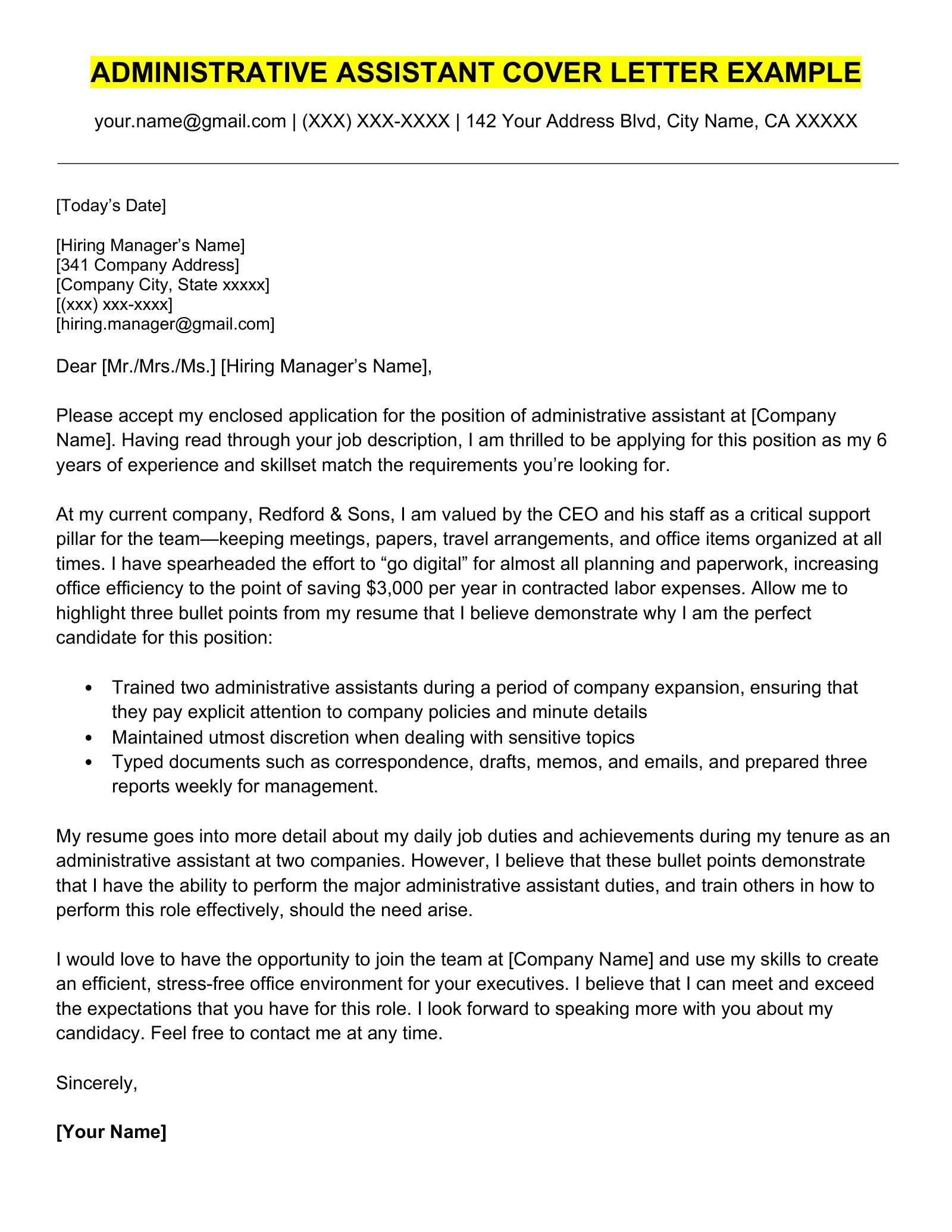
Here are some additional tips for writing a successful cover letter: Keep your cover letter concise and focused. Aim for one page. Use a professional tone and avoid slang or informal language. Highlight your key skills and accomplishments. Focus on what you can bring to the employer. Tailor each cover letter to the specific job and company. Research the company and understand their needs. Use action verbs to describe your experience. Quantify your achievements whenever possible. Proofread carefully for any errors. Get feedback from others before submitting. Remember to always be positive and enthusiastic. Tailor your cover letter to show how your skills and experience align with the company’s needs. By following these tips, you can significantly increase your chances of landing an interview and securing your dream job as an administrative assistant.
